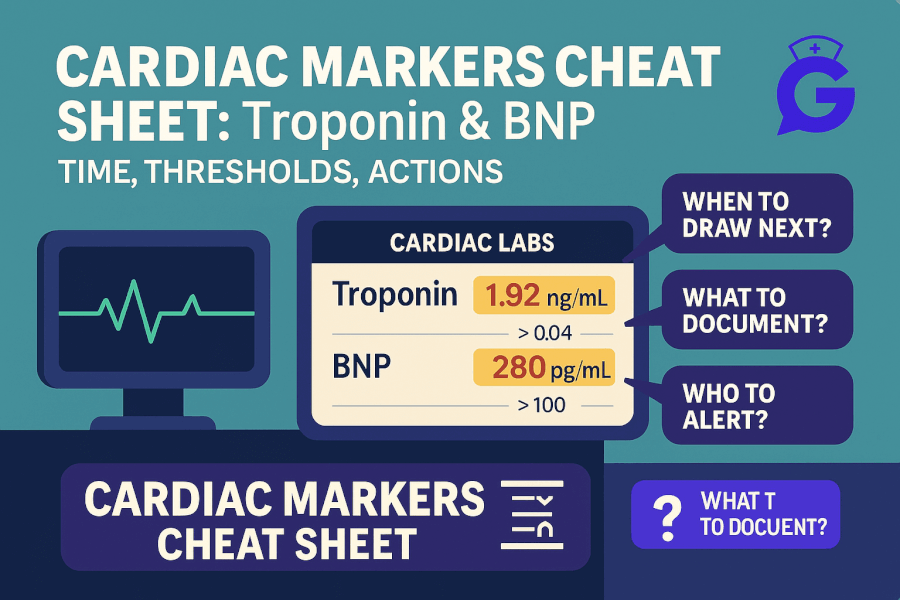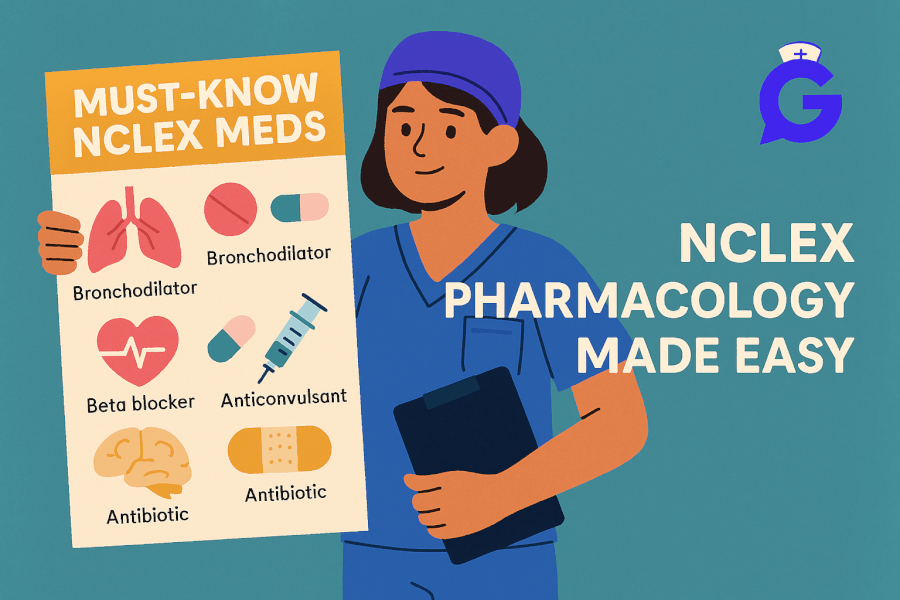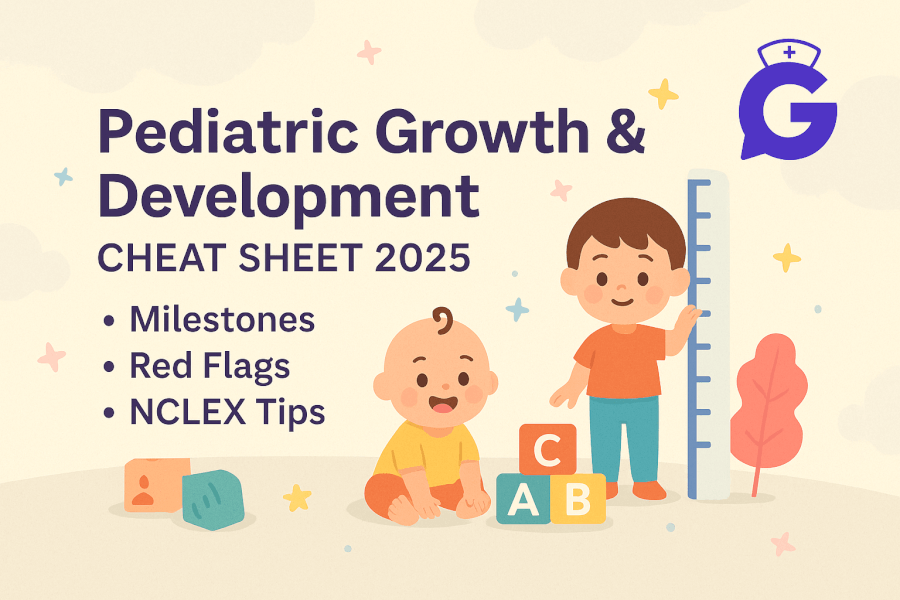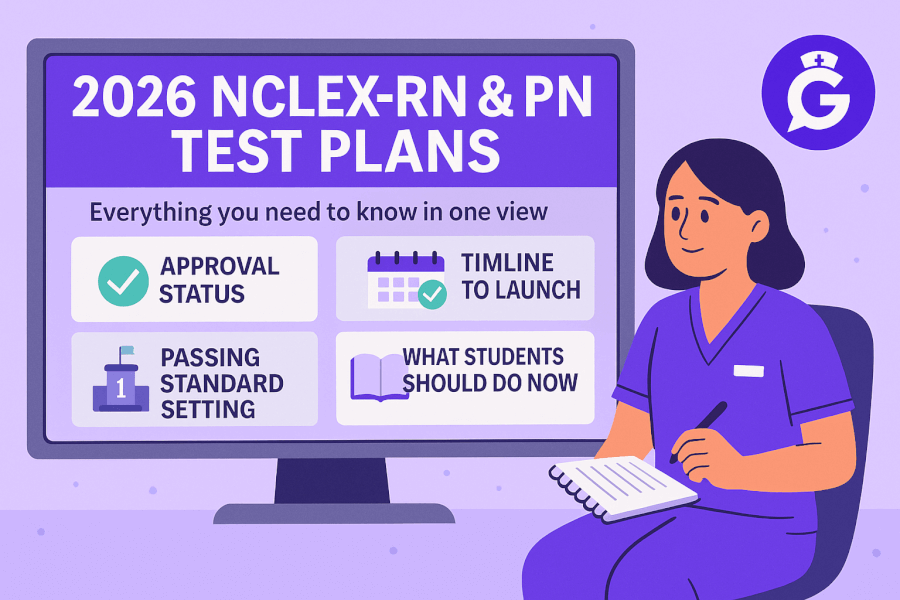When chest pain or dyspnea shows up on your shift, the labs start flying. This cheat sheet keeps troponin and BNP/NT-proBNP straight—what they mean, how they rise and fall, and what you should do first. Use the tables below before clinical, during simulations, or when an NGN stem throws cardiac labs and vitals at you at once.
If you need broader context for ranges, keep Normal Lab Values (2025): Printable Cheat Sheet open while you read. For mixed pictures (acidosis, hypoxemia) that influence cardiac workload, pair with ABG Interpretation Made Simple (2025). If stems feel crowded, reset with How to Read NGN Case Stems (2025).
Table of Contents
- How to Use This Cheat Sheet
- Troponin I/T: What It Shows & How It Kinetics
- BNP vs NT-proBNP: Heart-Failure Signal & Cutoffs
- Interpreting Patterns (Chest Pain vs Dyspnea)
- When to Worry: Red Flags & First Actions
- NGN Tie-Ins: Action → Parameter Pairs
- Sample Handoffs (SBAR)
- FAQs
- Further Reading
🎯 Free NCLEX quiz!
Test your knowledge - new quizzes added weekly!
How to Use This Cheat Sheet
- Name the priority in one sentence (ischemia vs volume/pressure overload).
- Pair two actions that change physiology now (oxygenation, perfusion, preload/afterload).
- Pick two parameters to reassess soon (SpO₂/MAP/ECG/urine output) to prove your actions worked.
- Use serial labs and the time course tables below to avoid premature conclusions.
Professor’s note: For troponin, one normal doesn’t rule out MI. Think serial measurements plus symptoms and ECG.
Troponin I/T: What It Shows & How It Kinetics
What it reflects: Myocardial injury (ischemic or non-ischemic). Values and reference intervals vary by assay—always compare to your lab’s cutoffs.
| Item | Key Points |
|---|---|
| Clinical role | Detects myocardial injury; interpreted with symptoms and ECG. A single result is a snapshot—**rise/fall pattern** matters. |
| Typical kinetics | Rises ~3–6 h after injury, peaks ~12–24 h, can stay elevated **days** (I/T differ by assay). High-sensitivity assays detect earlier changes. |
| Common non-ischemic elevations | Sepsis, renal failure, myocarditis, tachyarrhythmias, demand ischemia (supply/demand mismatch), pulmonary embolism. |
| Nursing watchouts | Trend troponin with **ECG changes**, **pain pattern**, and **hemodynamics**. If chest pain ongoing, treat oxygenation/comfort and prepare for rapid evaluation per protocol. |
Serial testing concept
- If initial high-sensitivity troponin is normal but suspicion is high, a repeat (e.g., at 1–3 h per protocol) helps capture a rise.
- A rising pattern supports acute injury; stable chronically elevated levels (e.g., renal disease) require clinical correlation.
🥇Voted #1 Nursing Study Tool.
Personalized AI Tutor + Instant Answers to All Your Questions. 100% Money Back Guarantee!
BNP vs NT-proBNP: Heart-Failure Signal & Cutoffs
What they reflect: Ventricular stretch/pressure—biomarkers that support a heart failure picture in dyspnea workups. Use with symptoms, exam, chest imaging, and response to therapy.
| Marker | What it means | General cutoffs & notes* |
|---|---|---|
| BNP | Natriuretic peptide released with ventricular stretch | Higher values suggest HF. Cutoffs vary by lab; obesity can blunt levels; renal dysfunction can increase levels. |
| NT-proBNP | Prohormone fragment; longer half-life than BNP | Age-adjusted thresholds are common; interpret with exam, CXR, echo findings, and response to diuresis. |
*Always use your lab’s reference intervals and local protocols.
Nursing watchouts
- Elevated BNP/NT-proBNP supports a HF physiology but isn’t specific to etiology (ischemic, valvular, hypertensive).
- Track response: oxygenation, work of breathing (WOB), urine output, edema, and weight—these matter more than the biomarker alone.
Interpreting Patterns (Chest Pain vs Dyspnea)
Chest pain pathway (ischemia suspected)
- Priority: Oxygenation + perfusion, rule-in/rule-out acute coronary syndrome (ACS).
- Labs/ECG: high-sensitivity troponins (serial), 12-lead ECG; consider precipitating factors (anemia, hypoxemia, sepsis).
- Actions: oxygen if hypoxemic; monitor ECG; IV access; pain control per protocol; prepare for further evaluation.
- Parameters: SpO₂, chest pain score, ECG changes, MAP.
Dyspnea pathway (HF vs pulmonary)
- Priority: Oxygenation + work of breathing; evaluate HF vs COPD/asthma/PE/pneumonia.
- Labs: BNP/NT-proBNP aid HF probability; ABG may show gas exchange issues.
- Actions: oxygen to target sats, position upright, diuretics per order for volume overload; bronchodilators if obstructive component.
- Parameters: SpO₂, RR/WOB, urine output, edema/weight, lung sounds.
Professor’s note: Don’t let a normal first troponin lull you. If the story and ECG worry you, advocate for serials and keep oxygenation/comfort optimized.
When to Worry: Red Flags & First Actions
-
Ongoing chest pain + ischemic ECG changes
First actions: oxygen if hypoxemic, continuous monitoring, IV access, rapid evaluation per protocol.
Parameters: SpO₂, pain, ECG rhythm/ST changes, MAP. -
Acute pulmonary edema picture (orthopnea, crackles, pink froth)
First actions: upright positioning, oxygen/positive pressure per protocol, diuretic per order, consider afterload reduction per team.
Parameters: SpO₂, RR/WOB, urine output, lung sounds. -
Low output signs (cool clammy skin, oliguria, hypotension)
First actions: perfusion support per protocol, rapid team evaluation.
Parameters: MAP, urine output, mental status, lactate trend (see ABG Interpretation for acid–base/perfusion context).
Link your decisions to realistic practice sets in Med-Surg / Physiological Adaptation Case Studies and to mixed-format items in the NGN Case Studies hub.
NGN Tie-Ins: Action → Parameter Pairs
- Suspected ACS with hypoxemia → actions: oxygen, monitor, prepare rapid evaluation → parameters: SpO₂, ECG, pain score.
- HF exacerbation with volume overload → actions: oxygen/position, diuretics per order → parameters: SpO₂, RR/WOB, urine output, daily weight.
- Demand ischemia (sepsis/tachyarrhythmia) → actions: treat underlying cause, support oxygenation/perfusion → parameters: MAP, lactate trend, symptoms.
- PE suspicion with dyspnea and tachycardia → actions: oxygen and rapid workup → parameters: SpO₂/WOB, hemodynamics.
🥇Voted #1 Nursing Study Tool.
Personalized AI Tutor + Instant Answers to All Your Questions. 100% Money Back Guarantee!
Sample Handoffs (SBAR)
SBAR — Chest Pain + Rising Troponin
- Situation: “Mr. R has ongoing chest pain 7/10 with new ST changes.”
- Background: “Pain began 90 minutes ago; first hs-troponin was normal; second just rose above cutoff.”
- Assessment: “Unstable chest pain with rising troponin; SpO₂ 93% RA, BP 102/62, HR 106; pain not relieved.”
- Recommendation: “Please evaluate for ACS pathway; we have IV access and monitoring in place; request orders for further management.”
SBAR — Dyspnea + Elevated NT-proBNP
- Situation: “Ms. K is short of breath with orthopnea and crackles.”
- Background: “History of HTN; NT-proBNP elevated; CXR pending.”
- Assessment: “Suspect HF exacerbation with volume overload; SpO₂ 90% RA, RR 26.”
- Recommendation: “Request diuretic per protocol and oxygen titration; we’ve positioned upright and started monitoring urine output.”
FAQs
Is one normal troponin enough to rule out MI?
No. Use serial high-sensitivity troponins plus ECG and symptoms to capture a rise/fall pattern.
Can BNP/NT-proBNP be high without heart failure?
Yes—age, renal dysfunction, pulmonary hypertension, and other factors can influence levels. Interpret with exam and response to therapy.
What if troponin is mildly elevated in sepsis?
Treat the underlying condition and support perfusion/oxygenation. A mild elevation can reflect myocardial strain; trend with the clinical picture.
How do I study this efficiently?
Pair this cheat sheet with quick ABG checks for perfusion/oxygenation context and run a few mixed NGN cases from the hub each week.







